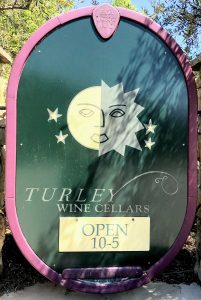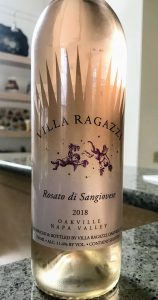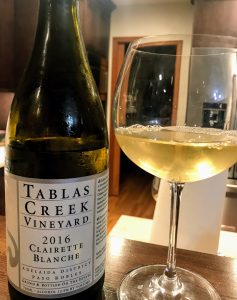I was playing around on my phone today looking for new games to download. On a lark, I decided to see what was available when I searched for Wine Games.

Unsurprisingly, there isn’t much. The available games tend to fall into the category of trivia (with the WSET wine puzzle game being the most interesting) or repurposed game designs like hidden objects, escape rooms and arcade games with wine as a backdrop.
So that got me wondering, where are the wine-focused games that combine entertainment and education? Like Speed Anatomy or Lumosity?
Where are the games that foster a social aspect with multiple users? Like Ingress?
Where are the games that encourage wine lovers to go out and explore an area, visit new wineries and just plain have fun with wine?
Where’s the wine world’s Pokémon GO?
Imagine …

A good one to visit while in Paso.
Imagine visiting a wine region like Paso Robles, Red Mountain or the Shenandoah Valley of Virginia. You have dozens of winery choices, many of which you may have never heard of before.
How do you pick which ones to check out?
You can scroll through Yelp reviews, check out winery websites or ask friends on Facebook. Of course, you could also purchase a wine travel book, check out the AVA website or maybe pick up a free map at your hotel. But how many of those options are actually fun?
Are these things that you really want to do? Or do they feel more like a chore that has to get done before you can get to the fun part?
For many consumers, a visit to wine country is a vacation — a chance to kick back with friends and family and just enjoy life. One of the last things that many consumers want to do is add research and homework to their vacation docket. Sure, wine geeks may have fun plotting out their wine tastings. But we are a rare breed. For a lot of consumers, they’re just going to go out, have fun and sort of “wing it”.
Wouldn’t it be great if the wine industry could tap into that “I just want to have fun and drink wine” mentality?
Wouldn’t it be great if we had a tool that actively encouraged engagement with consumers, instead of just sitting back and hoping that they come through our doors?
“Winging it” with a Purpose
I’m not a game developer so I’m mostly just spouting off the type of game that I would love to play. While I know that a small wine niche will never reach the level of popularity of Pokémon GO, there are some solid lessons from the game’s success that a developer could use.
1.) Make it a hunt.

A Sangiovese rose from Oakville fruit?!? This is a score on so many levels.
We don’t have pokémon but what we do have are hundreds of unique grape varieties and wine styles. While some (like Cabernet Sauvignon) are very common, others (like Teroldego, Norton and Grenache blanc) are more rare.
Create a system that assigns points based on the rarity of a grape variety within a region. So if you’re exploring the land of endless Cabs, Chards and Sauvignon blancs, stumbling upon a Napa Sangiovese or Riesling would earn you more points.
Seeking out new and exciting wines taps right into the Millennial wanderlust. But often there is an intimidation factor that comes from lack of familiarity and education. Turning that wanderlust into a game helps remove some of that intimidation.
Yeah, a wine consumer may not know what the heck Tinta Cao is but they know if they visit this one tasting room in Walla Walla to try it, they will earn beaucoup points. So why not?
2.) Make it competitive.
It’s human nature to want to be the best–even if all we’re doing is gathering imaginary gems and internet points. And if you have a leader board, it’s fun to see where you rank among your friends and strangers who are doing the same thing you’re doing.
Adding team elements and things like portals (wine bars) to battle over or gyms (cellars) to control would add complexity to the design, I’m sure. But having something to “fight over” makes that repeat visit to the tasting room more worthwhile. That is vitally important to the appeal of such a game to wineries. It’s great to get that one time visit, but repeated engagement is where the needle moves.
3.) Make it social.
Whether it creating teams with friends or easy sync up with your social media accounts, this is an absolute must. We live in a social media world and, especially if we’re having fun, we want to tell everyone about where we’ve been and the wines we’ve tried.
Benefit to Wineries

Tablas Creek would have like 20 some odd entries of different grapes. That would be a “gym” site for sure!
A significant hurdle for such a game is the upkeep of information about what wineries are pouring what wines. This is not a project that can be created in a vacuum without winery involvement. But to get that involvement, an app developer needs to demonstrate to wineries the value that participating in the game could have.
This could involve showing them that 92% of Millennials own smartphones and that mobile apps account for nearly half of all internet traffic.
In places like Napa and Sonoma, they’re already grappling with declining tasting room visits and seeking out innovating ways to bring people in. Even for wineries outside of the North Coast, it would be foolish to ignore the canary in the coal mine.
But the biggest benefit of such a game app will be for the small family wineries making wines that are both literally and figuratively off the beaten path. These are wineries that need exposure and often have an education hurdle to overcome with consumers embracing their unique wines and grape varieties.
Replacing the anxiety of the unknown with a competitive quest for the unique is one of the best ways to overcome those hurdles. That solution could be very appealing to a lot wineries–especially if their potential investment is just a small amount of time in keeping their data on the app up-to-date.
How Can This App Make Money?
Of course, no game developer is going to do this for free and I don’t think the Pokémon GO business model translates to my fantasy wine app.
Again, I’m not a game developer, so this part of the business plan is not my forte. You can take a look around this blog and realize that I’m also not really keyed into this whole “monetizing” thing either.
But I’m not planning on creating this game myself, so I’m sure that people a heck of a lot smarter than me will have better ideas.
But there are a few potential revenue streams I can see.
Priority Listings

I don’t mean to hate on Cab so much. It makes lovely wines but is just soooooooooooo overdone.
There are only so many unique grape varieties out there being produced. There is going to be a lot of overlap. If the game can gain traction and significant downloads, you could potentially market more favorable search listings to wineries that pay a fee.
So if you are a Woodinville winery doubling down on the same ole Cab and Bordeaux blends that everyone else is making, it may be worthwhile for you to pay for priority or “sponsored” placement to encourage visitors to play the game at your place.
Sponsored “Raids” or “gyms”
If a winery really wants to be proactive in bringing people to their locations, they could sponsor special events with bonus points and status for those who visit during a certain time. This basically follows a similar idea to Starbuck’s partnership with Pokémon GO. Yeah, a wine game is not going to get Starbucks’ sponsorship but what about local wine bar and restaurants? After all, engage wine consumers are engaged diners as well.
Good Old Fashion Ads
Yes, everybody hates them but they are par for the course with free apps. Plus, you can always offer a premium “ad-free” version for a cost.
Data
This is probably the biggest potential revenue stream. But it’s also the area where a developer has to be very careful with because of privacy laws.
But, let’s face it, an app that is collecting data on which tasting rooms that consumers are visiting, how long they are staying there, where they go next and potentially what they are sharing on social media is a goldmine of valuable information for marketers.
